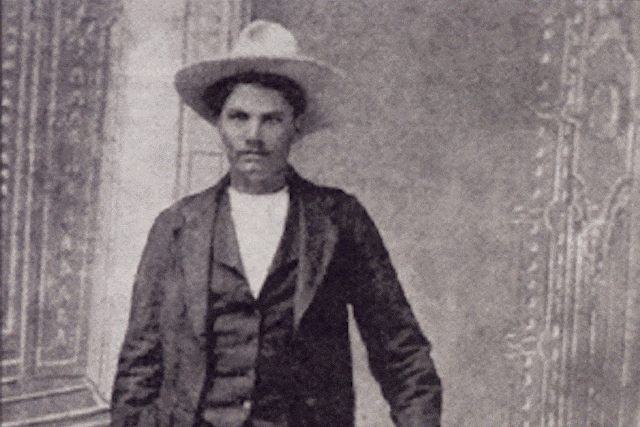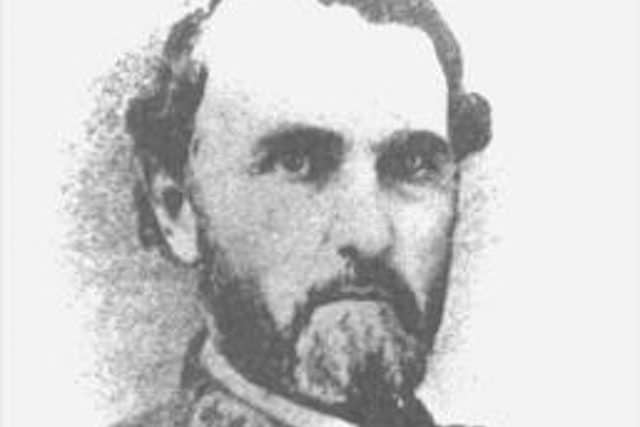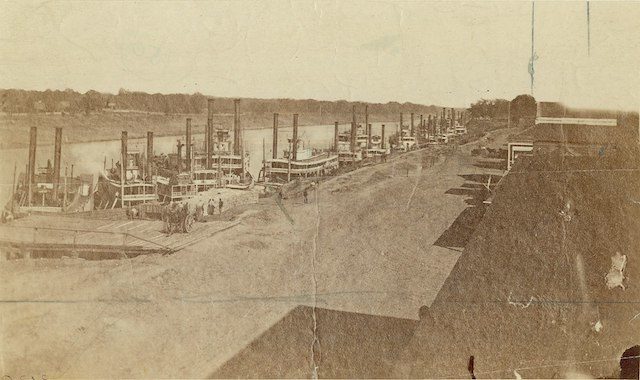The Hatfield and the McCoy feud during the second half of the 19th century is so well known, at least by name, that is has become a phrase used to describe mutual hostility among parties in all walks of life. Arguably it is the most famous feud of American history. There are many others, though, where hostility between families and their allies erupted in violence which lasted for years and claimed many lives. Feuds have been part of the American stereotyping of the “hillbilly” image applied to Appalachia, the Ozarks, and other regions across the United States, and in fact many have occurred in those areas. They have occurred in other areas as well.
The famous battle of the OK Corral in Tombstone was part of a feud between a group called the Cowboys and the Earp brothers. The gunfight at the corral was not the culmination of the feud, but the beginning of open warfare between the factions, which triggered the Earp Vendetta Ride in the spring of 1882. Like the Hatfield and McCoy feud, the actions of the Earps’, Clantons’ and their confederates are well known. Other feuds are less so, except in the regions where they occurred, where they are often exploited to lure tourists. Here are some lesser known American feuds from across the nation.
10. The Greene-Jones feud in North Carolina and Tennessee

The long feud between the mountain clans of the Greene and Jones families in North Carolina and Tennessee, which also spread into remote areas of Virginia and Kentucky, began over a pig. There are several variations of the tale, but the most common is that a pig owned by a Greene broke through a fence belonging to a Jones, and was killed for the trespass. In retaliation, a cast iron cauldron owned by a Jones was destroyed. Bad blood between the families had existed since the beginning of the American Civil War, and continued in its aftermath, with retaliatory killings between veterans of either side. It became known in newspapers as the Greene–Jones War.
The exact date it began is debatable, but from 1863 until the late 1880s the two families killed each other and each other’s friends and allies. The ambushes and murders which occurred eventually accounted for the deaths of 30 people, most of them men, though there was at least one child killed. On May 31, 1888, the Daily Democrat of Huntingdon, Indiana reported: “The Jones-Greene feud still rages in Hancock County” and that “Both sides go heavily armed.” It took the imposition of martial law and deployment of the Tennessee State Militia to bring the feud to an end around the turn of the 20th century.
9. The Colorado County Feud ran for nine years and involved a former state Senator

The Colorado County feud (also called the Reese-Townsend Feud) was a period of open warfare between political factions, centered around Columbus, Texas. It began, oddly enough, over an election for the office of County Sheriff. Incumbent Sheriff Reese was opposed by a former deputy named Larkin. Former state senator Mark Townsend, a political boss in the county who had once backed Reese changed his mind and supported Larkin. Larkin was shot on the street in broad daylight, by an unknown assailant. Friends of Reese were suspected. Townsend selected another candidate for sheriff, Will Burford, who won easily in 1898.
The following spring, supporters of Townsend (and Townsend himself) engaged Reese and his supporters in a gunfight on the streets of Columbus. Reese was killed in the exchange. But the violence continued, through a drive for vengeance sworn to by his sons. Beginning in May 1899 and continuing through May 1907, five separate gun battles between large parties from the two sides were fought in the town’s streets. City council refused to intervene by appointing a Town Marshal. It took the intervention of the Texas Rangers in 1907 to bring the feud to an end, but not before it claimed the lives of at least ten people, most but not all of them participants in the fighting. No one was ever convicted for any of the deaths in the feud.
8. The 12-year Lincoln County Feud in West Virginia was reported across the nation
The Lincoln County feud took place in the Hart’s Creek region of West Virginia from 1878 to 1890.It involved several families, all of them intertwined through marriage, including the Brumfields, Dingesses, Adkinses, Adamses, Halls, Runyons, and Nesters. The feud came to the attention of the national press in the 1880s. The complicated relationships and hostilities between the several families were further confused by newspaper reports, which focused on the violence between the Brumfields and the Adamses, as well as the feud between Al Brumfield and John Runyon.
At least four deaths over the course of the feud were confirmed at the time, though there may have been others, as several people were reported to have simply left the region to parts unknown. The various factions fought over stills, land ownership, timber rights, water rights, and past acts of hostility between the warring families. In September 1899, Al Brumfield and his wife were riding double on horseback when they were ambushed by two riflemen who then fled to Kentucky. An armed posse led by Brumfield retrieved them in October and brought them back to West Virginia, where both were killed. Within a year the feud came to an end, with Brumfield emerging as the region’s leading businessman.
7. Notorious outlaw John Wesley Hardin took part in the Sutton-Taylor feud in Texas

The Sutton-Taylor feud in DeWitt County, Texas was fomented by the turmoil within Texas during Reconstruction following the Civil War. The two factions were the Taylor family, led by Pitkin Taylor, and the Sutton family, headed by William Sutton, a rancher and deputy sheriff of Clinton, Texas. Sutton and his allies used deadly force when making multiple arrests, including those of some of the Taylor clan. In 1870 Sutton was appointed to the Texas State Police Force, established to enforce Reconstruction laws and protect the newly freed slaves from vigilantes. Sutton used his position to crack down further on the Taylor family, often returning from arrests with a dead body rather than a prisoner.
The Taylor and Sutton factions both grew to include up to 200 men. One of them on the Taylor side was John Wesley Hardin, who killed at least two Sutton allies in the feud: DeWitt Deputy Sheriff Morgan, and with help from another Taylor, and Jack Helm, the commander of the Texas State Police under whom Sutton was assigned. The 1875 Indianola hurricane also had an effect on the feud, when Billy Taylor, being held for trial on murder charges, escaped from the jail after being freed from his cell to avoid rising water. By the time the feud was brought under control by the Texas Rangers in 1877, 35 men of the two sides had been killed. Pitkin Taylor and William Sutton were among the dead.
6. The Black River War was a family feud which ran for more than two decades

The Black River War was a feud between two owners of Louisiana plantations which began in the antebellum years, took a break during the Civil War, and resumed during Reconstruction. The feud was between St. John Richardson Liddell, owner of a plantation named Llanada, and Charles Jones, owner of a plantation named Everly. Both plantations were on the Black River. Jones wanted to expand his holdings, and when he could not purchase land owned by another neighbor, Philip Nichols, he made disparaging remarks about Nichols’ wife, and she asked her friend Liddell to accompany her to confront him over his remarks. Liddell agreed.
When she approached Jones at his home, she suddenly pulled out a pistol and shot him. Jones survived and recovered, accusing Liddell of being complicit in the murderous assault (he was not). Both men began preparing for an armed confrontation, and the community divided into separate factions. In 1852 Liddell killed two men allied with Jones, claimed self-defense, and was acquitted after a long trial in 1854. Other challenges and accusations were hurled between the two men and Jones was suspected of hiring gunmen to assassinate his enemy. When the Civil War began, both men joined the Confederate Army, and the feud was temporarily put aside.
5. The second half of the Liddell-Jones feud

Both plantations suffered during the war, and their owners returned to find their holdings in serious financial straits. Liddell remained loyal to the Southern Democrats opposed to the policies of Reconstruction. Jones joined with the Republicans, established connections which served him well financially, and resumed the feud. When Liddell was forced to sell Llanada to pay his debts, Jones expressed interest in acquiring the property at auction through a third party. Liddell warned Jones that he would not allow such an event and the tensions between the two, exacerbated by Reconstruction policies, grew again.
In 1870 Jones and his two sons murdered Liddell on a steamboat bound for New Orleans. Arrested by a sheriff who was a political ally of the Jones family, they were not jailed but held in the Sheriff’s home. A mob, incensed at the murder of Liddell and at Jones’ profiting from Reconstruction policies at their expense, demanded that Jones be delivered to them. After he agreed to release the women in the house Jones tried to escape by leaving with them, wrapped in a blanket. He was recognized, shot, and killed. One of his sons was killed, one escaped. The feud ended, having lasted 20 years, and claimed up to 14 dead.
4. The 1870 Barber-Mizell feud in Florida led to over 40 deaths
Florida’s Barber-Mizell feud began as a dispute over taxes in 1870. Moses Barber was a wealthy cattle rancher with holdings in Brevard and Orange Counties. David Mizell was the Orange County Sheriff, responsible for tax collection. When Barber refused to pay taxes on his land and cattle, disputing Mizell’s jurisdictional authority, the latter simply seized cattle in lieu of payment. Barber considered the seizure rustling. Barber warned Mizell to desist. In February 1870 Mizell was on Barber’s land when he was ambushed and killed. His extended family swore revenge.
Some sources claim up to forty were killed in the feud between the Mizell and Barber clans which resulted from the dispute over taxes. The harsh conditions perceived by the Barbers from Reconstruction contributed to the violence; Mizells mostly supported the new laws, and enriched themselves by exploiting them. Orange County records confirm only eight deaths as a result of the feud. The feud was officially declared over in a service of reconciliation held as part of a local celebration called the Pine Castle Pioneer Days in 2013. A shotgun, said to be one used in feud related murders, was donated to the Orange County Regional History Center.
3. The Boyce-Sneed feud in Texas was triggered by marital infidelity, killing at least eight people

The Boyce-Sneed feud was between wealthy Texas cattle barons John Beal Sneed and Albert Boyce Jr. The cause of the feud was not grazing rights, water rights, or the fencing off of open range. Instead, it began when Mrs. Sneed, in late 1911, decided she preferred the company and home of Mr. Boyce. Her husband placed her in an asylum until she came to her senses. Boyce rescued her from the asylum and took her to his home. Sneed, pride stung, decided that Boyce was the true instigator of his wife’s faulty thinking and swore revenge against him. His first act of revenge was to kill Albert Boyce Sr, a banker.
Sneed got off in a mistrial for that crime, and in March 1912 his own father was killed as he walked down a Georgetown, Texas street. In September, Sneed ambushed and killed Boyce Jr, after which he surrendered to the authorities. He was tried separately for the murder of both Boyce father and son, acquitted both times. After his acquittal of the murder of Boyce Jr, reporters asked how an obviously guilty murderer could walk free, and the jury foreman replied, “The best answer is because this is Texas,” where a man had the “obligation to defend the honor of his home.” Eight deaths are attributed to the Boyce-Sneed feud.
2. The six-year Brooks-McFarland feud began with a failed robbery

The Brooks and McFarland clans lived in the vicinity of the Creek Nation in what is now Oklahoma and northern Texas, both having developed unsavory reputations by the late 19th century. In 1896, Thomas Brooks, having learned that a retired Texas Ranger kept a considerable sum of money in his home, decided to relieve him of it. He was killed in the failed robbery. The Brooks family decided that a member of the McFarland clan had masterminded the robbery and sent Brooks to accomplish it, and further decided vengeance was theirs. In addition to the failed robbery, the two clans had a long history of annoying each other by stealing livestock and other things of value.
The feud lasted from 1896 until 1902, when the two leaders of the contending clans met their ends. Willis Brooks was killed in a shootout between clan factions in Spokagee (now Dustin), Oklahoma. His death decapitated the Brooks faction. The following month, October 1902, Jim McFarland, his counterpart from the enemy faction, was ambushed and killed as he rode in a buggy with his wife. With his death the feud petered out. The feud featured many of what would become staples in western films, including bar brawls, jail breaks, escapes to Mexico to avoid pursuit, and gun battles. Five men were known to have been killed, though some claim there were many more, over the course of its six years.
1. The French-Eversole feud in Kentucky was instigated on both sides by lawyers

Joseph Eversole and Benjamin French were merchants, businessmen, attorneys-at-law, and former friends in Southeastern Kentucky. Although some who now exploit the feud for tourism claim that the feud began over a woman, with an Eversole employee threatened by French, others believe the triggering argument was a dispute over coal rights. Whichever is true, both sides began building armed factions in 1886. Attorneys Eversole and French decided to resolve their legal disputes through extralegal means, and the feud was on.
Murder by ambush was the preferred tactic of both sides of the feud, rather than pitched combat between large parties of armed men. In 1888 Joseph Eversole was ambushed and killed in such an attack while with a party of legal officials riding to circuit court. The feud intensified, and in 1889 a pitched battle known as the Battle of Hazard occurred around Hazard Court House. Extensive newspaper coverage described the feud throughout the south and Midwest. It came to an end in 1894, though in 1913 French encountered Eversole’s widow and son on a Hazard street. The son, Harry Clay Eversole, drew a pistol and shot French, who died from the wound over one year later. Harry was convicted of disturbing the peace and paid a fine of $75.